In today’s fast-evolving technology landscape, innovation plays a pivotal role in shaping future product portfolios as industries explore new ways to streamline business operations, deliver efficiencies, and deepen customer engagement. However, with the accelerating pace of change, it’s essential to separate the innovations which will disrupt…
Omri Kohl, CEO & Co-Founder of Pyramid Analytics – Interview Series
Omri Kohl is the CEO and co-founder of Pyramid Analytics. The Pyramid Decision Intelligence Platform delivers data-driven insights for anyone to make faster, more intelligent decisions. He leads the company’s strategy and operations through a fast-growing data and analytics market. Kohl brings a deep understanding of…
PS5 Breaks Sales Record But Still Falls Short Of Target After Crossing 59 Million Units Sold

Sony Interactive Entertainment has revealed in its latest financial earnings report it sold 20.8 million PlayStation 5 units in the fiscal year that ended on March 31. In doing so, Sony sold more than any fiscal year since the console’s launch in November 2020. However, despite that achievement, Sony still fell short of its original PS5 sales target for this year, missing it by more than 4 million units.
Originally targeting 25 million units for the fiscal year ending March 31, 2024, Sony sold 20.8 million, bringing the grand total up to 59 million, despite the 4 million units miss. As noted by VideoGamesChronicle, however, Sony revised that 25 million unit target in February to just 21 million; it still didn’t hit that target, though, just narrowly missing the mark.
[embedded content]
At 59 million units, the PS5 is just behind the PlayStation 4’s 60 million units at the same point in its life cycle. However, Tokyo-based video game analyst Serkan Toto told VGC that 20.8 million units sold is likely going to remain the peak for the PS5, and that this number would have been much lower if not for the release of Helldivers 2 in February, which is PlayStation’s fastest-selling game ever after selling 12 million copies in 12 weeks.
On the earnings call, Sony told investors to expect gaming sales to decrease in the fiscal year that just began (and ends March of next year) due to an expected decrease in console sales. There are also no major games from existing franchises releasing between now and then, according to the company. However, Sony says it still plans to release Concord, the new multiplayer online shooter IP from Firewalk Studios coming to PS5 and PC, this year.
For more about PlayStation, read about how Hermen Hulst and Hideaki Nishino have been named dual CEOs of the company, and then read Game Informer’s Stellar Blade review. After that, check out Game Informer’s Final Fantasy VII Rebirth review.
How do you feel about the PlayStation 5 at this point in its lifecycle? Let us know in the comments below!
The Art Of The New Dungeons & Dragons
Dungeons & Dragons has a big year ahead of it. The classic tabletop RPG is celebrating its 50th anniversary this year, and the most significant event of that celebration is undoubtedly the release of a revision for the game’s core rules, including the Player’s Handbook, Dungeon Master’s Guide, and Monster Manual. Backwards-compatible with the entirety of the 5th edition of the game, the new books are nonetheless a big new step forward for the game, reflecting a decade of iteration and evolution as the game has exploded in popularity.
The books aren’t far off. Players and Dungeon Masters alike can watch for pre-orders starting on June 18; each book is set to be priced at $49.99. Each of the three new books comes in at a hefty 384 pages apiece.
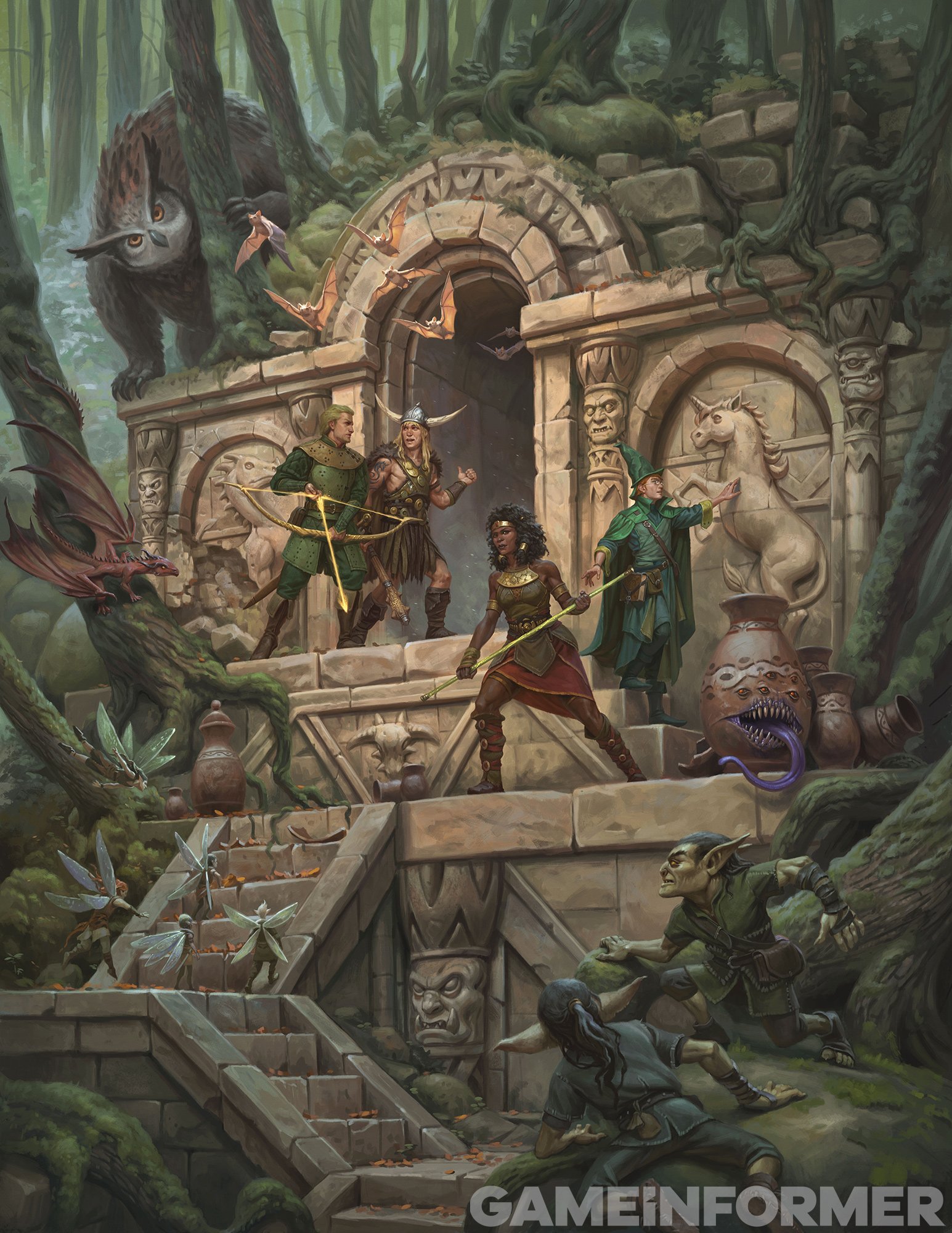
Characters from the classic D&D cartoon get a makeover in this internal art from a chapter opener in the new Player’s Handbook. Artist Credit: Dmitry Burmak
We had the good fortune to visit Wizards of the Coast a few weeks ago to learn more from the artists and designers about what to expect in the revised game, and we have a ton of exclusive details about the revised D&D in this month’s Game Informer magazine. The magazine article includes extensive insight from Wizards of the Coast designers, including Chris Perkins and Jeremy Crawford. Our conversations with the designers offer great depth into what to expect out of each of the three core books on the way. We hope you’ll support that kind of exclusive coverage of D&D with a subscription to GI for less than $2 an issue so you can check the article out for yourself.

In addition to all the fun new design insights discussed in our magazine article, we also wanted to show off some of the remarkable art coming as part of the latest books. We’re including that here, alongside details from the art team working to craft the game’s look.
We’re especially excited to reveal a close look at the cover art for the new Player’s Handbook.
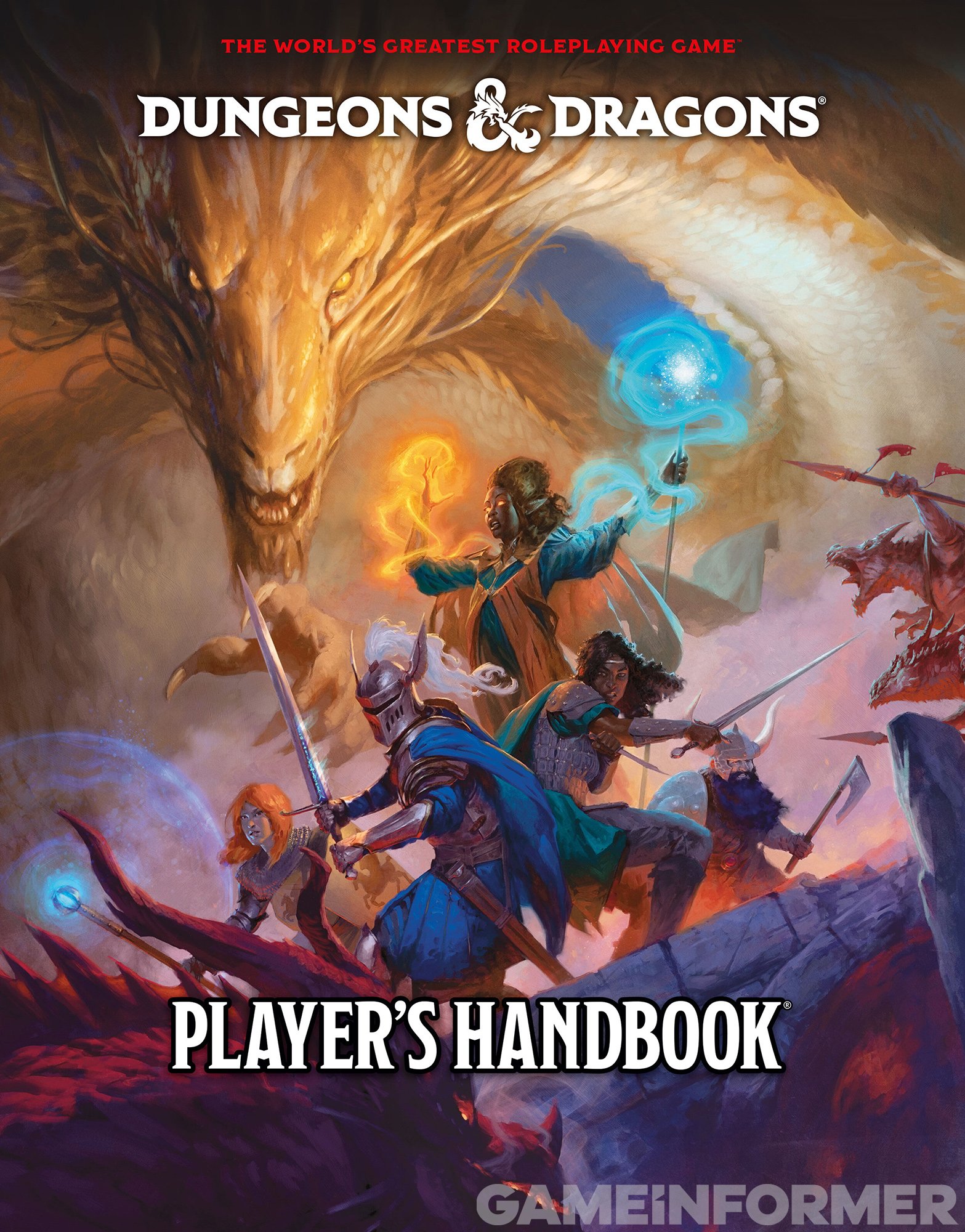
The front cover of the newly revised version of D&D’s Player’s Handbook. Artist Credit: Tyler Jacobson
As the first planned release of the three new core rulebooks, it’s also likely the one that’s most important to the broadest swath of D&D players; its appearance in each prior edition has helped define the tone of the game.
The new Player’s Handbook front cover embraces the game’s revitalized approach to pushing forward legendary characters from across the history of the game. We see the likes of Yolande the Elven queen, Strongheart the knight, Elkhorn the Dwarven warrior, the divine Mercion, and the rogueish Molliver, all charging together into an adventure. These are figures hearkening back to the earliest era of the game. Wrapped around them is a benevolent gold dragon – a nod to the “golden” 50th anniversary of the game and an enticing reminder that the dragons in the game’s title can be allies as frequently as enemies.
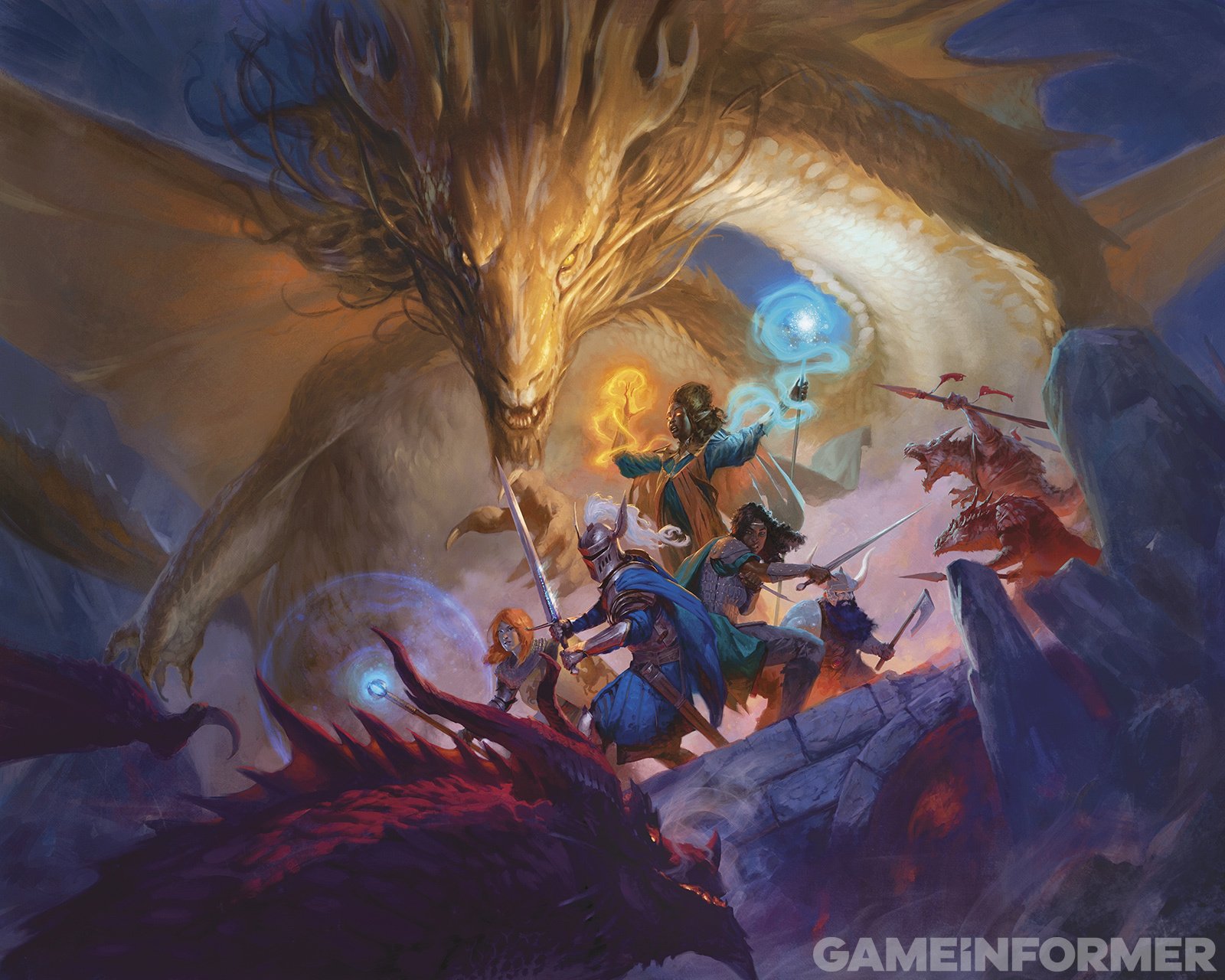
A gold dragon teams up with a party of legendary heroes to confront a red dragon and its kobold minions in the full front cover art for the new Player’s Handbook. Artist Credit: Tyler Jacobson
The new cover art comes from the experienced hand of freelance illustrator, Tyler Jacobson. “I’ve worked on DND since 2009. And I did the covers back in the fifth edition,” Jacobson says. “I did the Player’s Handbook and the Dungeon Master’s Guide, as well as many of the other covers that came after that for [titles] like Storm King’s Thunder and Volo’s.”
The direction for the cover art is highly intentional, meant to reflect the content inside. “With the cover art, we wanted to represent each experience,” Jacobson says. “How do we make the Player’s Handbook look like it’s the players’ experience? And how do we make the Dungeon Master’s Guide feel like the Dungeon Master’s experience?”
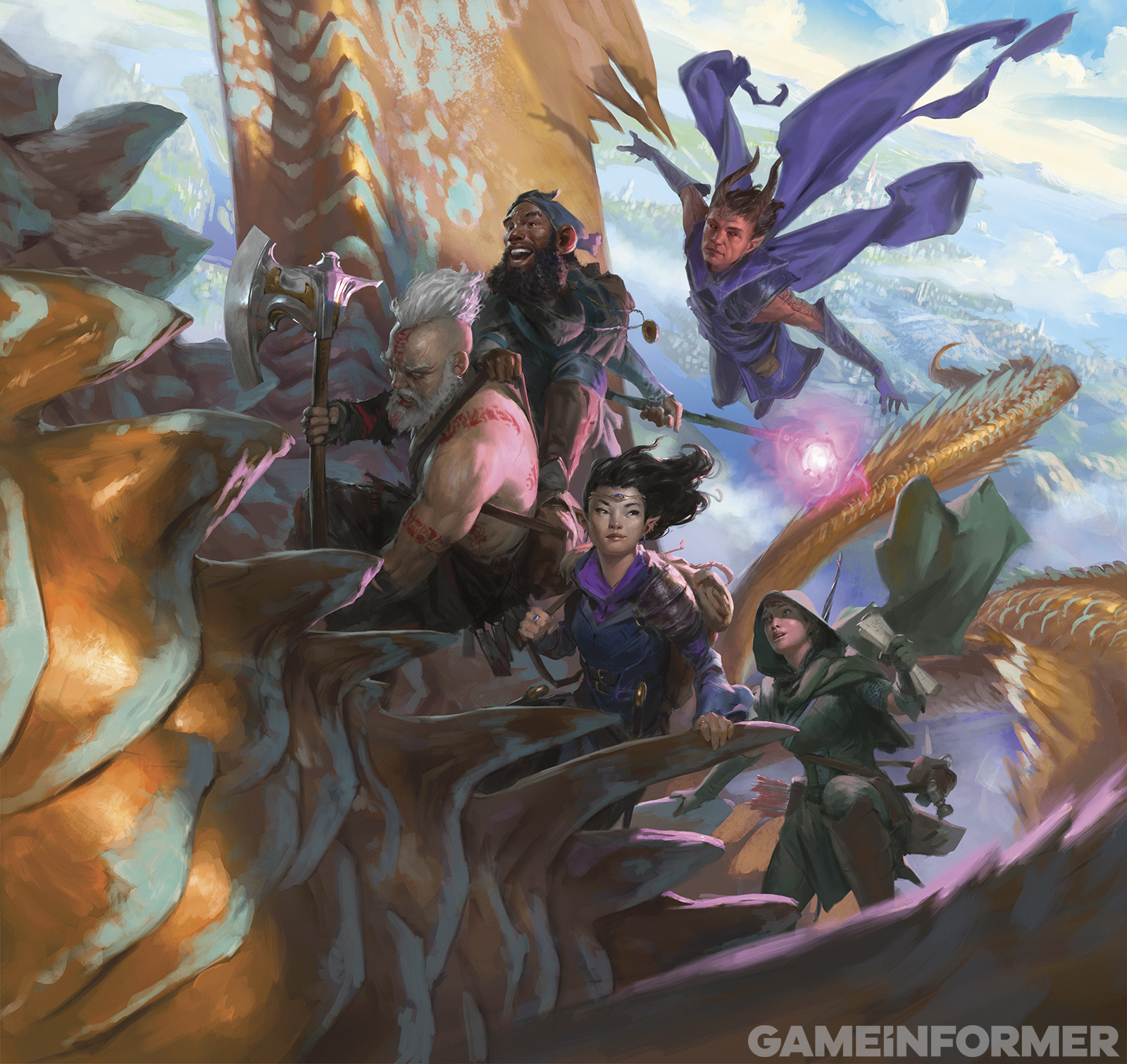
The back cover of the Player’s Handbook features an unknown party of adventurers flying into danger on the back of a bronze dragon. Artist Credit: Tyler Jacobson
A separate piece of art on the reverse side of the Player’s Handbook goes the other direction from the mythical heroes depicted on the front, depicting a party of unknown heroes, and nodding to players who will craft their own legends.
The new Player’s Handbook (and all the rulebooks moving forward into this new era of the game) features a red book spine, which, in my mind, subtly nods to some classic visual cues like the classic red boxed set from the 1980s. But whether that’s intentional or not, the red hue also easily sets the new books apart from any other recent rulebooks you have on your shelf.
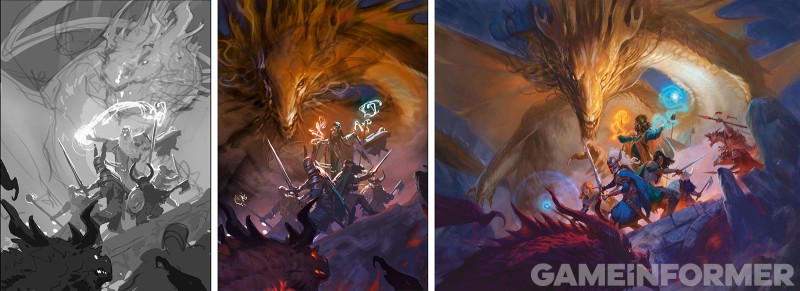
From sketch to completed art of the new Player’s Handbook. Artist Credit: Tyler Jacobson
Early book printings will bear a D&D 50th seal on the back – a recognition of the big five-decade anniversary.
As fans have come to expect, you can also look forward to alternate book covers available in your local game store – the new alternate Player’s Handbook depicts a gorgeous scene of elves and a sinuous gold dragon, all printed in a gold foil treatment.
Beyond the cover, there’s no shortage of art filling the books’ pages, as evidenced by the extensive visuals we saw from the interior pages of the Player’s Handbook.

Artist Néstor Ossandón Leal shows the process from sketch to completed art. Artist Credit: Néstor Ossandón Leal
“A lot of our chapter openers are famous heroes,” says studio art director Josh Herman. “Almost every chapter opening features a different hero, or group of heroes in a different setting. So, you’ve got Dragonlance, and other ones, like Ravenloft; you’ve got a whole suite of them. Whereas the Dungeon Master’s Guide is all about villains. The cover is all about the villains and the sort of threats that the DM gets to play up. And in that art, you get to see a lot of our famous locations and some of our famous villains in its chapter openers. So, it’s sort of like the opposite side of the coin; we want to present all of the facets of the game in a way that hopefully people can understand.”
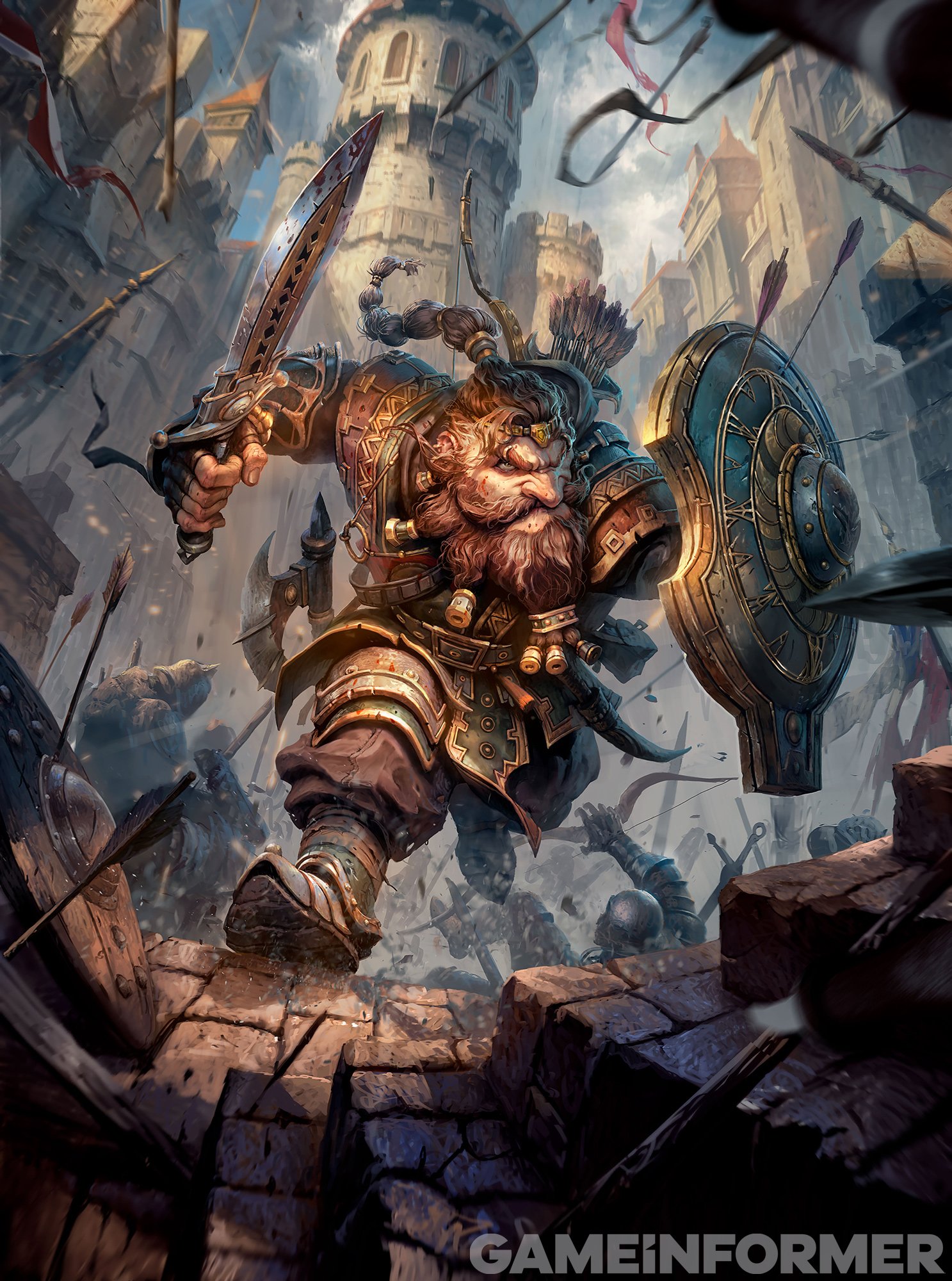
The completed art that launches the Fighter class section in the Player’s Handbook. Artist Credit: Néstor Ossandón Leal
I was especially struck by the mix of characters and settings on display in the revised books. Where many prior official books seemed to default to the familiar Forgotten Realms setting (chief home of the Baldur’s Gate video games), these new core books seem to embrace the multiversal nature of D&D, including the characters and locations of myriad worlds. “I think like 10 years after [5th edition’s launch], all of these settings have come out,” Herman says. “Like Spelljammer, Dragonlance, Planescape. That’s probably why the differences are so much there; we want to show off all the different ways that players can play just like you can choose any type of character, and we want to create a broad gamut for you to pick from.”
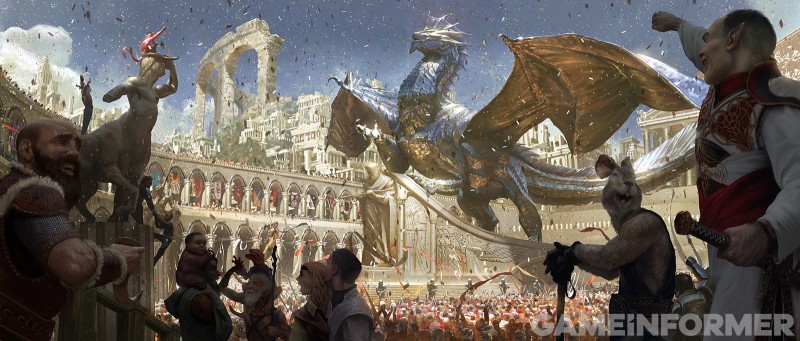
A silver dragon enjoys the adulation of a city’s parade route. Artist Credit: Campbell White
The art in the new core books has a chief goal of helping to further an understanding of the game. Spells are often shown being cast. Art for character backgrounds shows a possible place your hero could have come from. It even extends to the visuals of creatures in the Monster Manual. “There’s a lot of mindfulness about the mixture; to pick the monster design accurately to the stat block,” says art director Emi Tanji. “If it’s a creature that does slashing damage or something like you want to make sure we see claws. And you want to make sure if the art has shows something that’s like a stinger, but there’s nothing in the stat block – that would be weird, right?”
As I had the chance to explore completed pages during my visit to Wizards of the Coast, I was impressed by the bounty of art that fleshes out the books and how the art is presented to act as a visual tool for organization. “We worked with the design team to ensure that every class starts with the left-hand page,” Herman says. “Whereas before in 2014, it was just kind of a running journal. Now what we wanted to do is every class would open with a full-page piece of art on the left-hand side with a similar set of lead data on the right hand, so that every time you get to a new class, you get sort of an immediate visual, which we tried to theme around almost like an iconic version of what that class is.”
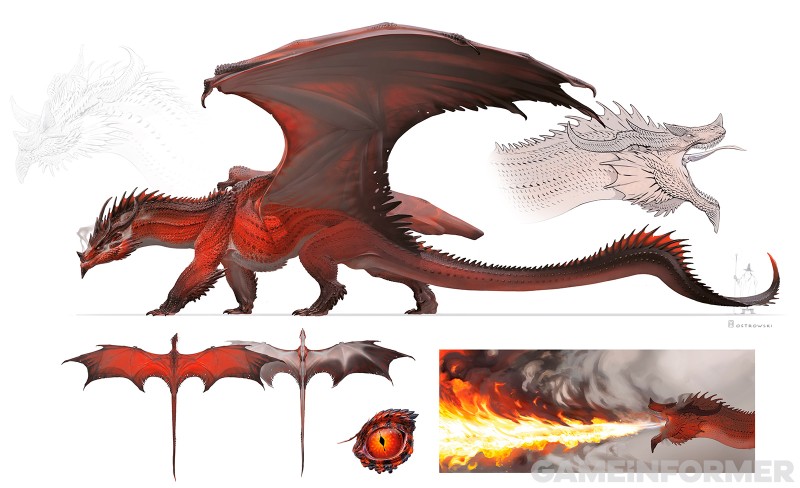
Concept art reveals the redesigned look for the red dragon. Artist Credit: Alexander Ostrowski
The revised books also gave the art and design team at Wizards of the Coast a chance to return to some of its most iconic visuals and refine the approach, including the titular dragons of the classic five metallic and five chromatic species. “All the dragon stuff was really great,” Herman says “We went through all 10 of them. We have new designs for all of those and there will be a lot of that in the Monster Manual for sure. We are trying to update those designs to be something in which players could see that dragon’s personality or what biome they live in, or where they fit in the cast of all of the dragons.”
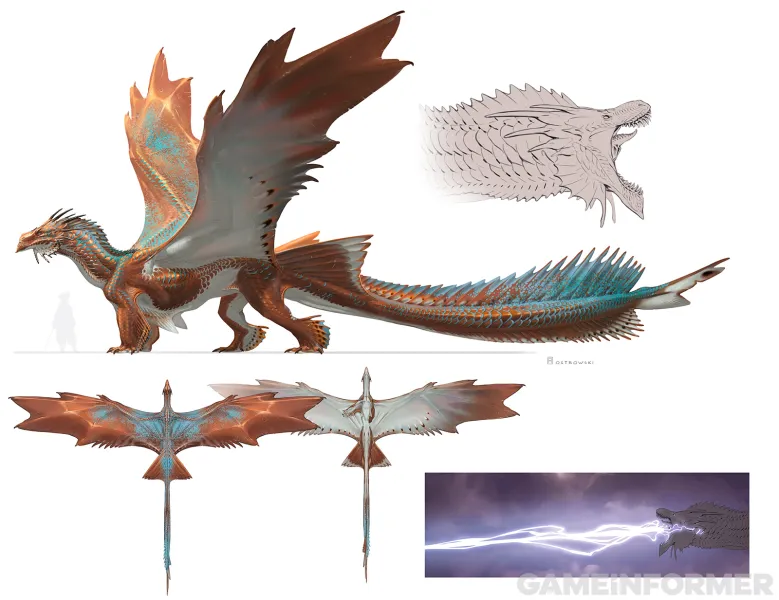
The new look for the bronze dragon, and concepts for its breath weapon. Artist Credit: Alexander Ostrowski
As a longtime D&D player, I came away from perusing this new version of D&D with a lot of excitement. The art we’re sharing here publicly is just a sampling of what I had the opportunity to look over; there’s a cohesive visual language to the new books that is enticing. And I love the way the game seems to embrace the long history of heroes, villains, and iconic named monsters that have arisen over 50 years of play.
If the art on display here has you excited, I hope you don’t miss out on our in-depth tour of the design work expressed in the books themselves, as described in this month’s Game Informer magazine. Our eight-page article includes details on all three books, including new character options, building player bastions, new apex-tier monsters on the way, and the surprising importance and inclusions of what is arguably the oldest D&D campaign setting of them all – Greyhawk. In a magazine that is chiefly focused on video games, we figuratively rolled the dice on offering this level of depth on a tabletop game like D&D in one of our issues, thanks to its incredible influence on gaming, and its recent success and reach to newcomers. If that kind of coverage is something you like, we’d appreciate your support in checking out the magazine.
In the meantime, enjoy exploring the breadth of all this new Dungeons & Dragons art! Click through the gallery below for full-size images of all the art included in this article, plus additional first-look pieces on the way in the new books.
GPT-4o delivers human-like AI interaction with text, audio, and vision integration
OpenAI has launched its new flagship model, GPT-4o, which seamlessly integrates text, audio, and visual inputs and outputs, promising to enhance the naturalness of machine interactions. GPT-4o, where the “o” stands for “omni,” is designed to cater to a broader spectrum of input and output modalities….
Hermen Hulst And Hideaki Nishino Named Dual PlayStation CEOs Following Jim Ryan’s Departure

Sony has appointed Hermen Hulst and Hideaki Nishino as dual CEOs of PlayStation, following Jim Ryan’s departure from the company this spring; they will begin June 1. Ryan announced he was leaving PlayStation last year, with Sony Group Corporation COO and CFO Hiroki Totoki stepping in as interim CEO following his departure in March. After that brief stint, PlayStation is tackling the CEO position with two figures, each with different focuses.
Hulst has been appointed CEO of SIE’s Studio Business Group while Nishino has been appointed CEO of SIE’s Platform Business Group. Totoki, now through as interim CEO, will serve as a Chairman of SIE in addition to returning to his role as COO and CFO of Sony Group Corporation. Both Nishino and Hulst will report to Totoki.
[embedded content]
“Sony Interactive Entertainment is a dynamic and growing business that delivers incredible entertainment experiences through the connection of content and technology,” Totoki writes in a press release. “These two leaders will have clear responsibilities and will manage strategic direction to ensure the focus remains on deepening engagement with existing PlayStation users and expanding experiences to new audiences.”
Nishino was the senior vice president of PlayStation’s Platform Experience Group, “responsible for developing the experiences and technology with PlayStation products and services,” including the PlayStation 5, PlayStation VR2, and PlayStation Network. Sony says in his new CEO position, he will continue to be responsible for technology, products, services, and platform experiences. He will also oversee third party publisher and developer relations and commercial operations, including sales and marketing of hardware, services, and peripherals, the press release reads.
“We will continue to connect players through world-class products, services, and technology,” Nishino writes. “We always strive to grow our community even bigger with innovation in every area at Sony Interactive Entertainment. I am honored to be appointed such an important role alongside Hermen. By working more closely together, we will be positioned to build incredible experiences for an ever-expanding audience now and in the future.”
[embedded content]
Hulst was the senior vice president and PlayStation Studios head, responsible for “developing content across many devices including PlayStation consoles and PCs, and bringing video game IP to new mediums such as film and television through PlayStation Productions.” As CEO, Hulst will be responsible for the development, publishing, and business operations of first party content.
“I am thrilled to lead the studio business group and continue to build on our success with PlayStation 5, while preparing for the future,” he writes in the press release. “The video game industry is one of the largest entertainment industries in the world and has been built on the marriage of content and technology, and I look forward to continuing to push the boundaries of play and entertainment.”
Totoki says in a separate blog post that later this month, players will “learn more about the long-term vision for Sony Group and the essential role SIE plays in that vision,” hinting that the company might have some kind of event happening in May. He adds, “[Fiscal Year 2024] marks the start of the Mid-Range Plan period for Sony Group in which we will set the course for sustainable growth.”
For more about PlayStation, read Game Informer’s Stellar Blade review, and then read Game Informer’s Final Fantasy VII Rebirth review. After that, check out this Game Informer interview with former PlayStation boss Jack Tretton about acquisitions, live service games, E3, and more.
What do you think about PlayStation’s dual CEO approach? Let us know in the comments below!
Helldivers 2 Is PlayStation’s Fastest-Selling Game Ever, Crossing 12 Million Copies In 12 Weeks
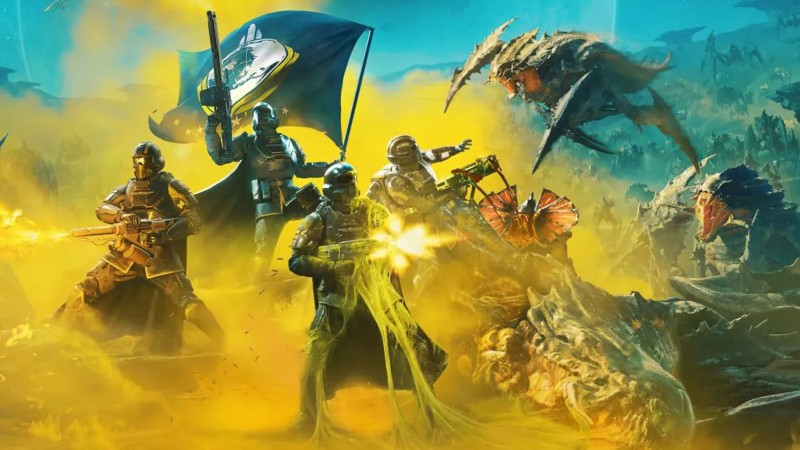
Helldivers 2 is PlayStation’s fastest-selling game ever, the company has announced in its latest financial earnings call. It achieved this title after crossing 12 million copies sold in 12 weeks, beating out the record previously held by God of War Ragnarök, which sold 11 million copies in 10 weeks, as reported by VideoGamesChronicle.
Developer Arrowhead Game Studios’ live-service multiplayer shooter sequel hit PlayStation 5 on February 8, with a simultaneous PC launch that same day, which is new for PlayStation. Its usual PC strategy sees PlayStation games launching on PC years after the game’s console release – Ghost of Tsushima Director’s Cut is only just now coming to PC this month, for example. It seems launching on PC day-and-date with PS5 was the right call, though, as Helldivers 2 is now a bonafide hit for PlayStation.
[embedded content]
Arrowhead Game Studios CEO Johan Pilestedt celebrated the news, noting there are more Helldivers 2 players than Swedes (the studio is based in Stockholm, Sweden) while thanking players for helping the team and PlayStation reach this achievement.
As announced in the Sony earnings call, we have sold over 12M units!
It’s crazy to think that there are more Helldivers than there are Swedes 🤯
What a massive achievement from everyone involved in realizing @Helldivers2. A massive thank you to the community for your support,…
— Pilestedt (@Pilestedt) May 14, 2024
Notably, Arrowhead Game Studios is independent – PlayStation published Helldivers 2 as a PS5 console exclusive, in a way previously referred to as second-party. However, given acquisitions are happening more and more this generation, it wouldn’t be surprising if PlayStation attempted to bring Arrowhead Game Studios under the first-party umbrella.
For more, read Game Informer’s Helldivers 2 review, and then read about how PlayStation recently walked back its Helldivers 2 PlayStation Network changes.
[Source: VideoGamesChronicle]
Are you one of the 12 million Helldivers 2 players? Let us know in the comments below!
The market size in the AI market is projected to reach $184bn in 2024 – AI News
We can often get very excited about breakthroughs in Artificial Intelligence and how there will be seismic changes in the way in which it shapes the future. However, as those interested in AI know, the technology is very much already embedded in so many of our…
AI is changing the shape of leadership – how can business leaders prepare? – CyberTalk

By Ana Paula Assis, Chairman, Europe, Middle East and Africa, IBM.
EXECUTIVE SUMMARY:
From the shop floor to the boardroom, artificial intelligence (AI) has emerged as a transformative force in the business landscape, granting organizations the power to revolutionize processes and ramp up productivity.
The scale and scope of this shift is fundamentally changing the parameters for business leaders in 2024, presenting new opportunities to increase competitiveness and growth.
Alongside these opportunities, the sophistication of AI – and, in particular, generative AI – has brought new threats and risks. Business leaders across all sectors are dealing with new concerns around data security, privacy, ethics and skills – bestowing additional responsibilities to consider.
To explore this in more detail, IBM commissioned a study, Leadership in the Age of AI. This surveyed over 1,600 senior European executives on how the AI revolution is transforming the role of company leaders as they seek to maximize its opportunities while also navigating its potential threats in an evolving regulatory and ethical landscape.
Powering AI growth in Europe
With seven out of ten of the world’s most innovative countries located in Europe, the region is well-positioned to capitalize on the soon-to-be-adopted EU AI Act, which offers the world’s first comprehensive regulatory framework. This regulatory confidence and clarity is expected to attract additional investments and new participants, further benefiting Europe’s AI ecosystem.
Against this promising backdrop, it is no surprise to see generative AI deployment at the top of CEOs’ priorities for 2024, with 82% of the business leaders surveyed having already deployed generative AI or intending to this year. This growing sense of urgency is driven by a desire to improve efficiency by automating routine processes and freeing employees to take on higher-value work, enhancing the customer experience and improving outcomes.
Despite this enthusiasm, concerns around security and privacy are tempering the rate of adoption – while 88% of business leaders were excited about the potential of AI within their business, 44% did not feel ready to deploy the technology yet, with privacy and security of data (43%), impact on workforce (32%) and ethical implications (30%) identified as the top three challenge facing business leaders. Instead of solely focusing on the financial benefits of AI, business leaders are now compelled to actively address the societal costs and risks associated with it.
A new era for leadership
Leadership in the age of AI requires executives to strike a balance between addressing the ethical and security implications of technology and harnessing its competitive advantages. This delicate balance lies at the core of the EU AI Act, endorsed by the European Parliament in March. It aims to promote innovation and competitiveness in Europe while ensuring transparency, accountability and human oversight in the development and implementation of AI.
The Act takes a risk-based approach, ascertaining the level of regulation required by the level of risk each use case poses. This spans from prohibitive, which includes practices such as social scoring; high-risk, which encompasses areas such as infrastructure and credit scoring; medium-risk, which includes chatbots and deep fakes; and low-risk, containing AI-enabled games and spam filters.
With these parameters in place, business leaders must realize regulatory compliance and prepare their operations and workforce for the upcoming shift. They must manage risk and reputation and future-proof their companies for further innovation and regulation, which will inevitably follow in the coming years.
There are two major priorities for business leaders in achieving this. The first is to create effective AI governance strategies built upon five pillars: explainability, fairness, robustness, transparency and privacy. These aim to promote transparency in data usage, equitable treatment, defence against attacks, system transparency and privacy protection.
Underpinned by human oversights, they will serve to mitigate risks and ensure AI systems are trustworthy. This comprehensive governance approach fosters responsible AI adoption, building trust among users and stakeholders while ensuring the ethical and responsible use of AI technologies.
The second, and equally important, action is to establish an AI ethics board. While the Act itself necessitates a certain level of ethical compliance, businesses should use this opportunity to establish their own ethical frameworks.
This will guide implementation now while laying out clear guardrails for future innovation. At IBM, for example, our ethical framework dictates what use cases we pursue, what clients we work with and our trusted approach to copyright. Establishing these foundations early serves to help prevent reputational risks or Act breaches further down the line.
The skills responsibility
There is also a clear responsibility for equipping workforces with the necessary skills to successfully navigate AI transformation. Another recent IBM study around AI in the workplace found that 87% of business leaders expect at least a quarter of their workforce will need to reskill in response to generative AI and automation.
Those who equip themselves with AI skills will have a significant advantage in the digital economy and job market over those who do not. Organizations are responsible for helping their employees upskill or reskill to adapt to this changing ecosystem.
Businesses take this duty seriously, with 95% of executives stating they are already taking steps to ensure they have the right AI skills in their organizations, and 44% actively upskilling themselves in the technology. The incentive comes from a competitive and a societal perspective, ensuring that large portions of the workforce are not excluded from participating in and benefiting from the thriving digital economy.
With legislative frameworks now in place, European CEOs and senior business leaders must navigate the evolving AI landscape with trust and openness, integrating good governance principles into its development and adoption, cementing ethical guardrails and building resilience across the workforce. This new era of leadership demands trust and transparency from the top down and will be a critical component for growth and return on investment.
This article was originally published via the World Economic Forum and has been reprinted with permission.
